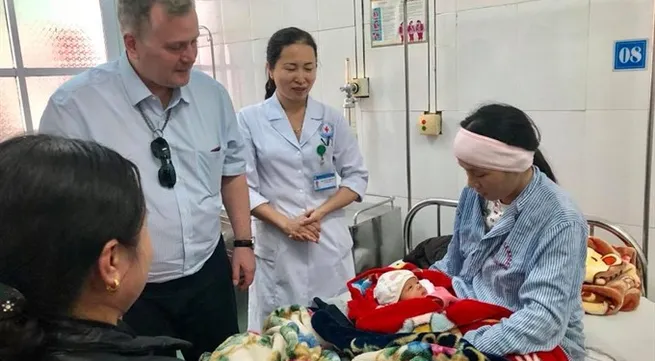Mothers, children get good healthcare


|
| Bjorn Andersson, Regional Director of the United Nations Population Fund (UNFPA) Asia Pacific Regional Office visits a mother and her newborn at the Vân Đồn District Medical Centre. |
QUẢNG NINH — Lưu Thị Tân is a happy, relieved mother.
The 26-year-old ethnic Thái woman has given birth to two healthy daughters with minimum fuss, which in itself might not be something extraordinary, but considering that she and her husband are, in her own words, "floating on rivers all day to earn our living," she has reason to be thankful.
It is thanks to the careful support and supervision of local medical workers during her pregnancy and delivery that Tân was able to safely deliver her two children.
The native of the central province of Thanh Hóa used to be worried about many women in her community and hometown give birth at home, exposing themselves to a lot of risk.
After their marriage, Tân and her husband moved to Vạn Yên Commune, Vân Đồn District in the northern province of Quảng Ninh.
They fish in rivers for a living and earn about VNĐ2-4 million (US$90-180) per month. Despite this, she was able to receive good, regular care, courtesy the Vạn Yên Commune Medical Station.
“Although my husband and I are on the boat most of the time, the medical workers still call and tell me to return to the mainland for examination,” said Tân.
She had four prenatal examinations during her pregnancy, and vaccinations on schedule.
“Thanks to the good care, I did not have any problems from when I became pregnant till giving birth to my daughters safely,” she said.
When her date drew close, the staff asked her to move to the Vạn Yên Commune Medical Station and wait for delivery.
Tân’s first daughter is five years old and her second daughter is two months old. They have also received their vaccinations on schedule.

|
| Lưu Thị Tân (right) listens as a staff of the Vạn Yên Commune Medical Station advises her on taking care of her baby daughter. |
Lê Thị Chiên, head of the Vạn Yên Commune Medical Station, said that despite a manpower shortage, the staff tried their best to take care local residents’ health, especially pregnant women and women in the child-bearing age.
The station does not have a doctor. With 338 households in the commune, the two physician assistants and two nurses are kept busy all day.
On average, about 30 women in the commune get pregnant each year, so there is need for constant attention.
“We go to different houses in the commune and inform the women how important it is to breastfeed their babies for at least the first six months. We also guide them on the weaning process and try to ensure that vaccinations are administered as scheduled,” said Chiên.
The station also conducts courses on reproductive health for young persons and women having children under two years old in the commune.
District support
In providing reproductive healthcare for women and girls, the commune station is helped by medical staff at the district level.
Vũ Thị Thanh Thủy, deputy director of the Vân Đồn District Medical Centre and also head of its Obstetrics Ward, said four doctors and nine nurses in the ward worked with “all their heart” to fufill their tasks.
“All women of child-bearing age are given information and advice related to reproductive health and safe pregnancy,” said Thủy.
The medical staff regularly attends professional training courses in the province and also in other localities.
The centre receives a lot of support from upper-level hospitals, said Thủy.
“In serious cases, we consult with provincial obstetrics and paediatrics hospitals and ask for guidance,” she said.
Thanks to this co-operation, patients do not have to move around much, and are able to save a lot of time and effort.
‘Midwives, nurses are heroes’
Visiting the Vạn Yên Commune Medical Station and the Vân Đồn District Medical Centre, Bjorn Andersson, regional director of the United Nations Population Fund (UNFPA) Asia Pacific Regional Office, said “I have very good impressions of what happens in the clinics and how the patients are treated."
Andersson said that he found that at the medical station and centre in the commune and district, respectively, he found that the staff maintained good contact with patients as they discussed with young pregnant women how they were feeling, and found out if they were getting enough nutrition and food.
“The medical staff is doing heroic job. Midwives and nurses who help women deliver safely, they are heroes,” he said.
“Việt Nam has made progress in reproductive health and reproductive rights,” he said.

|
| A doctor examines a newborn at the Vân Đồn District Medical Centre. |
Three zeroes
Delegates attending the 9th Asia Pacific Conference on Reproductive and Sexual Health and Rights (APCRSHR), which was held in Hạ Long City, Quảng Ninh Province from Monday to Thursday last week, lauded Việt Nam’s efforts to affect changes in sexual and reproductive health and rights (SRHR) in the country.
The conference was hosted by the Việt Nam Public Health Association with support from the UNFPA and other partners.
It was the first time that the conference is being held in Việt Nam, which has faced big challenges on SRHR-related policies and legislation.
Speaking at the conference, Natalia Kanem, executive director of the UNFPA, said that Asia-Pacific – and the world – have embarked on the 2030 Agenda for Sustainable Development, underpinned by the 17 Sustainable Development Goals.
“We seek to achieve a life of dignity for all to truly leave no one behind. At UNFPA, we are about to embark on a strategic plan to fulfill three transformational zero goals for our region and our world: zero maternal deaths, zero unmet family planning needs, and zero gender-based violence and harmful practices,” she said.
“We applaud Việt Nam as a shining example for having reached Millennium Development Goal 5, improvements in maternal health, ahead of time,” she said.
But even before pregnancy and childbirth, every woman and girl should enjoy her right to freely decide when or whether to start a family and how many children she wants to bear. Planning and spacing pregnancies are still key to reducing maternal deaths, said Natalia Kanem.
Health and sustainable development
In a message sent to the conference, Minister of Health Nguyễn Thị Kim Tiến said that to sustain gains under the Millennium Development Goals and to attain targets of the Sustainable Development Goals by 2030, especially in mountainous and remote areas, among ethnic minorities and other population groups, Việt Nam’s health sector will focus on a number of population and reproductive health themes.
She said that the country would continuously develop its reproductive health regulations and policies, and implementation of good practices and replicable models which are responsive to the health challenges and needs of ethnic minorities, adolescents and youth, ageing population, as well as migrants and workers in industrial zones.
She said the health system would be strengthened toward achieving universal healthcare and better access to reproductive health services with priority given to vulnerable populations and disadvantaged areas.
The nation would invest in the expansion and improvement of the quality of adolescent and youth-friendly health services, including the strengthening of comprehensive sexual and reproductive health education and life skills in the school system, and establishing specific contraceptive programmes for young and unmarried people, she said.
In another message, Vice President of Việt Nam Đặng Thị Ngọc Thịnh, said that she was “optimistic that this conference in Việt Nam will provide an excellent platform for scientists, researchers and programme officers in Việt Nam to meet, listen, share experiences and come up with comprehensive solutions.”
She said that over the last few years, the Vietnamese Communist Party and Government have enacted many policies and legal documents, allocated resources for family planning and SRHR, and have achieved many important outcomes. The indexes in this field are relatively good compared to other countries with the same level of per capita income, she said.
Statistics compiled by the health ministry shows that Việt Nam’s performance on the health of mother and child is better than many countries at the same per capita income level. The maternal mortality ratio (MMR) declined significantly from 233 in 1990 to 69 per 100,000 live births in 2009.
The United Nations estimates that Việt Nam’s MMR further declined to 56 per 100,000 live births in 2015. The infant mortality rate has also decreased significantly from 44.4 in 1990 to 14.9 per thousand in 2014. The under-five mortality rate also went down from 58 per thousand in 1990 to 22.4 per thousand in 2014. — LV
Tags:





